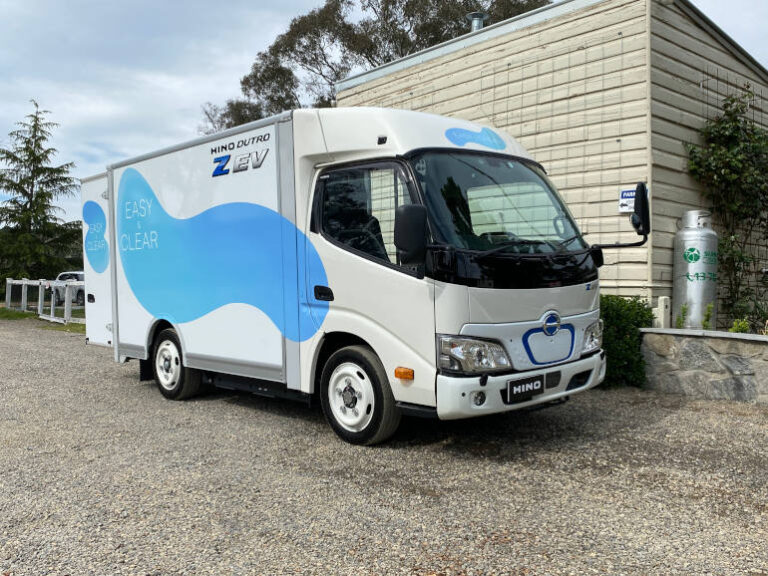As Australia’s commercial vehicle sector navigates one of the most complex transitions in its history, Hino has laid out a clear and practical roadmap for the future — one that includes diesel, hybrid electric, battery electric (BEV), and hydrogen fuel cell technologies.
Speaking at recent business briefings, Hino Australia’s President and CEO Richard Emery, and Manager of Product Strategy Daniel Petrovski, outlined how the company sees the future of powertrains evolving, and what that means for operators trying to balance cost, performance and sustainability.
Hybrid Is the Now
Both Emery and Petrovski were unequivocal about the relevance of hybrid electric trucks — especially the Hino 300 Series Hybrid — as the most viable low-emission solution available today.
“If anything, the jury is out for the moment on BEV,” said Emery. “The reality is that, just as happened with passenger cars, we think we’ve hit the sweet spot with hybrid, and we think that sweet spot has at least five years head start on BEV.”
Petrovski backed this up with data, explaining how hybrid can deliver a 20–29% reduction in fuel use and emissions, without the infrastructure, range anxiety or payload compromises of BEVs.
“CO₂ is about 20% less. Fuel use was about 20% less, and therefore your costs are less, the maintenance is less — but the driveway price was more. That gap has come down a lot,” he said, citing a recent real-world fuel efficiency trial conducted in Bathurst.
The results? One truck could save over $38,000 in fuel across a seven-year life. “Multiply that by a customer who owns 10 trucks — that’s a huge amount of savings,” Petrovski said.
Diesel Still Matters
Despite the industry’s shift to low-emission technologies, Hino does not believe diesel is going anywhere soon — particularly for heavy-duty and long-distance operations.
“Diesel powertrains remain the preeminent solution, and probably this will be the case through to 2030 at least,” said Emery. “Will they be assisted by hybrid? In most cases, yes — they’ll have some type of electrification.”
Petrovski added that even as the market heads toward 2050, diesel will still have a place in specific applications. “Will they be assisted by hybrid? Most cases, yes,” he said. “That’s our roadmap out to 2050.”
Battery Electric – Application Specific
Hino sees BEV as a technology best suited for urban and short-range delivery tasks, where payload isn’t a critical factor and where recharging infrastructure is available.
“BEV has a place in those short-haul, lighter weight applications where payload is not as critical,” Petrovski said. “The Dutro ZEV is an operation-specific solution — great for Japanese cities with tight hub-and-spoke operations.”
However, he noted key differences in market readiness between Japan and Australia. “It makes sense in Japan, because they have great electrical infrastructure — they have nuclear — and that’s a green solution for BEV,” he said. “Whereas we’re pumping coal electricity into our BEVs. There’s no environmental benefit in this market versus Japan.”
The limited infrastructure, higher energy costs, and up-front pricing make BEVs a tough sell for many Australian fleet operators, especially when they’re looking at ROI, not just image.
“In our market, the people that we deal with are actually looking at a return on investment… not just being a marketing tool for the green image of their company,” Petrovski said.
Hydrogen – The Long Game
For heavier, long-haul applications, Hino sees hydrogen as the most likely zero-emission alternative — eventually.
“Fuel cell electric vehicles would be the way of the future for that area, just because of the energy density of hydrogen versus battery electric,” Petrovski explained. “Payload is king for operators.”
He noted that a kilogram of hydrogen has roughly 100 times more energy density than a kilogram of batteries — a game-changer for large trucks travelling long distances.
Hino is already testing hydrogen fuel cell trucks in Japan, including 700 Series models, and Emery confirmed the brand is committed to covering all fuel technologies.
“Only one brand in Australia is working on solutions across all of these options, and that’s us,” Emery said. “We have our existing diesel offering. We have an existing hybrid offering in 300 Series. We are undertaking a trial on a Dutro EV. And Hino has hydrogen trials underway in Japan.”
What’s Next?
While Hino isn’t placing bets on a single fuel solution, the brand is adamant that each technology has a role — depending on the application, infrastructure and timing.
The next few years will see Hino:
- Expand its 700 Series Euro 6 range (including 13-litre AMT models for heavier duty roles).
- Fill fleet gaps with hybrid 300 Series as diesel transitions to Euro 6.
- Continue testing the Dutro BEV in Australian conditions.
- Monitor customer needs and infrastructure rollout to determine when BEV and hydrogen become commercially viable.
As Emery summed it up: “Transport runs on tight margins. Downtime, cost, range — it all matters. Hybrid hits that sweet spot today, and we’re ready for what comes next too.”






